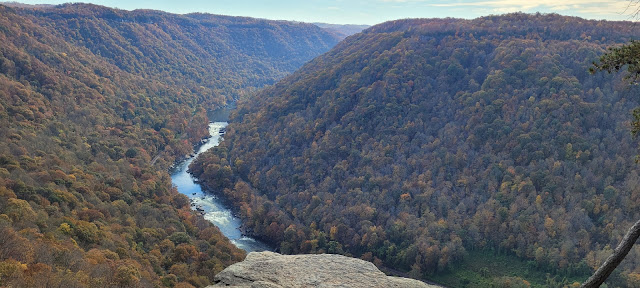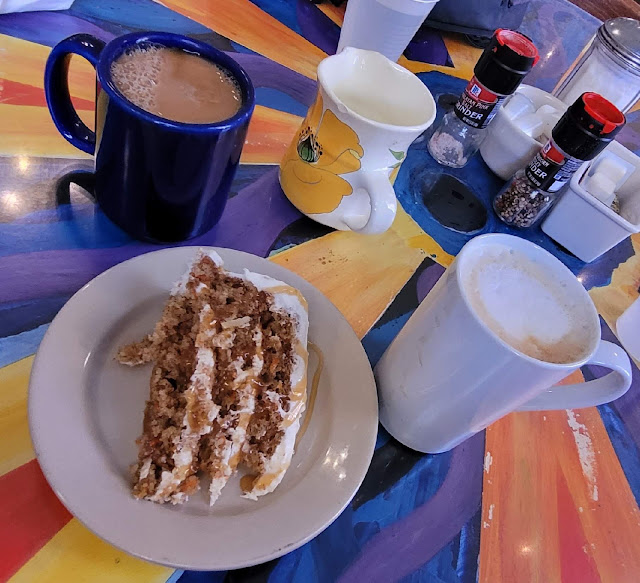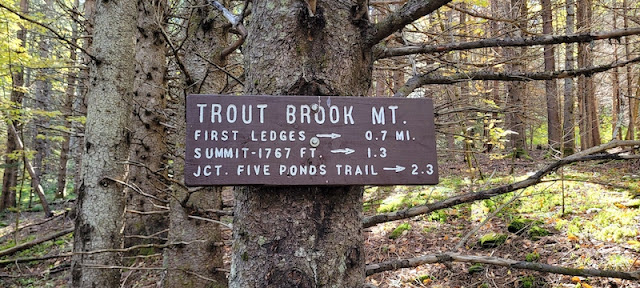Recap: My husband and I drove our Pleasure Way RV van, Sweet Van-Ella Magnolia, from the East Coast to the West Coast. On October 22, 2022, we left Midlothian, Virginia, where Ella had been in storage. We drove through West Virginia on our way to the Bourbon Trail. Our destination was Palm Springs, California.
In Pursuit of Bourbonism — October 26 & 27, 2022
We left West Virginia and entered the forested hills and valleys of the Eastern Kentucky Coal Field. Layers upon layers of sediment collected here for 250 million years when seawater covered the land. Each new layer compressed previous layers, and the pressure turned seashells into limestone and peat swamps into coal.
 |
The tasting at Woodford Reserve included a souvenir glass. |
Limestone makes the best water for the best bourbon, and coal has powered the electricity and much of the economy of Kentucky for two centuries.
We drove west on I-64 to the Outpost RV Park in Salt Lick and stopped for the night. The Outpost was a wide-open, spacious park run by warm country folk. When I called to make a reservation several weeks earlier, the man on the phone, whose voice sounded elderly, only took our name. I imagined him penciling us into a big, bound reservation book.
“That’s it?” I asked.
“That’s it,” he said.
I was used to filling out online forms and providing a long list of information—vehicle length, number of people, pet information, hookups needed—as well as a deposit and credit card information.
 |
Much of western Virginia, West Virginia, and eastern Kentucky was covered in soft-peaked mountains and pastureland where black Angus cattle grazed. |
We saw lots of licks around these parts. And hollows, traces, and gaps. A lick is where a spring with salt reaches the surface. The salted spring attracts animals that lick the salt and mineral deposits left by the spring. Historically, animals created paths or traces through the woods and mountains that Native American hunters, traders, and later pioneers used before modern roads were built.
A hollow (pronounced holler in these parts) is a small valley. A trace is a beaten path or minor road, a track. A gap is a low area between two higher-elevation land masses. A gap is more rugged than a pass. A notch is more rugged than a gap.
Traveling on these roads through the mountains reminded me of the illustrated children’s book, Who Came Down That Road? by George Ella Lyon and illustrated by Peter Catalanotto. A young boy walks with his mother through the woods and asks, “Who came down that road, Mama?” The mother answers him, and the boy repeatedly asks, “Who came before that?”
We found Allegheny Mountain Radio, the listener-supported community radio station in Dunmore, West Virginia.
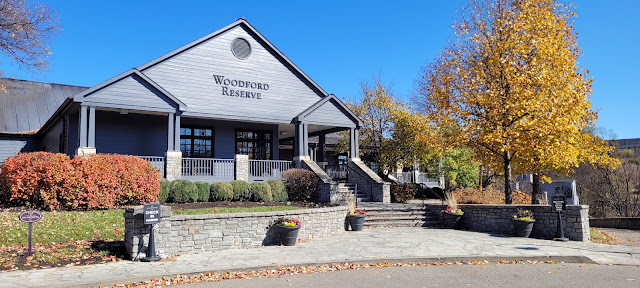 |
| Woodford Reserve offers several tastings and tours at its Versailles, Kentucky, distillery. |
We started our Bourbon Trail adventure at Woodford Reserve in Versailles, Kentucky. (Pronounced Ver-SAL-Less.) Roger did the Signature Tasting while I enjoyed sitting and reading in the sun on Woodford’s beautiful campus. After Roger’s tasting, we went to the Cocktail Bar, where Roger sampled another pour. (I had a few tiny sips to taste, but I prefer wine.)
Absentee Voting in the Midterm Election
It was important to both of us to do everything possible to vote in the critical mid-term elections, so before arriving in Louisville, we visited the Woodford County Library in Versailles, where we printed our electronic delivery ballot from the Alaska Division of Elections. The email they sent after we requested online delivery (back in Marlinton, WV) included a link and a code to access our ballots.
We filled out the ballot online, then downloaded and printed them at the library. We opted to fax rather than snail mail them back to Alaska. By faxing, we gave up privacy, but we didn’t want to risk our ballots being delayed by the U.S. Postal Service. If we had wanted to return the ballots by mail, the ballot package included a template for an envelope we could have cut out, folded, and taped.
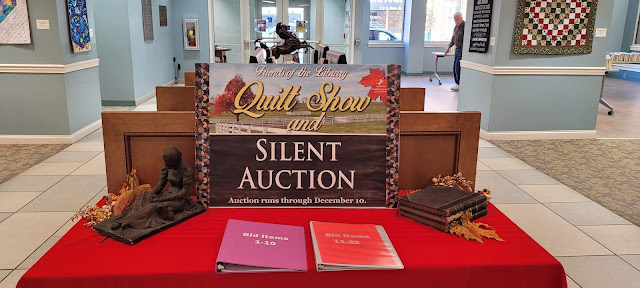 |
| Quilts and artwork on display throughout the Woodford County Library were part of a silent auction fundraiser. |
This family operation included 55 cats! You’d never know it. I didn’t smell cats or litter boxes and only saw two cats in the store and laundry area.
 |
| The view from our back-in site at Louisville North Campground. |
The park was surprisingly quiet, with just the low rumbling of a train going by now and then on a railbed just above our site. The other guests were a combination of retired people like us enjoying the on-the-road lifestyle. We also observed workers who lived in the park and left early each morning for their jobs as contractors and laborers. It looked as if one young family lived there full-time. Children played with toys lying about their campsite and road through the park on an oversized tricycle.
Bourbon and Baseball — October 28, 2022
We took an Uber to Main Street, downtown Louisville, and the Louisville Slugger Museum. The tour walked us through the production area and included extensive baseball history and memorabilia exhibits. The Bat Vault contained more than 3,000 bat models or templates from celebrity players such as Babe Ruth and Ted Williams, who designed their own bats. The company has been making baseball bats since 1884 and displays an essential part of American history and its favorite pastime. Today, bats are made mainly by computerized machines. The factory workers operated and fed the machines, added details, and completed other tasks machines couldn’t do.
 |
The tour guide demonstrated how bats were once turned by hand on a lathe. |
We continued down Main Street for more bourbon tasting at Michter’s Fort Nelson Distillery, Evan Williams, and Old Forester downtown. We ate lunch at Jockey Silks Bourbon Bar and later had a drink at Merle’s Whiskey Kitchen.
 |
We tasted a flight at the Old Forester bar. |
Jockey Silks, located inside the Galt House Hotel, had great reviews. I enjoyed the upscale whiskey bar decor—fancy compared to our unlux travel style.
We walked to Angel’s Envy, where Roger had a distillery tour reservation at 6 pm. The bar was open only to tour guests, and tours usually fill up weeks in advance. A guide told me same-day visitors are often disappointed when they arrive and can’t taste or tour. When we made a reservation a few days in advance, a 6 pm spot was one of only two left that day.
 |
Inside the Angel’s Envy Distillery in downtown Louisville, Kentucky. |
Since I’m not a whiskey, I mean bourbon, drinker, I waited in the reception area while Roger toured the distillery. While I waited, three different staff people invited me to the bar to meet Roger at the end of his tour. I kept declining because I was perfectly content sitting quietly, people-watching, and reading. When the third person insisted, “Your husband asked me to get you,” I went up the elevator to the beautiful bar. Roger was like a kid in a candy store and showed me around as if he worked there.
Angel’s Envy was Roger’s favorite bourbon experience, and the rye with the Caribbean Cask finish is his favorite bourbon. We didn’t purchase a bottle there because we knew we could buy it in Juneau for about the same price. (We needed to travel light for our eventual plane ride home.) However, Roger did buy a bottle of Old Forester to enjoy during the rest of our RV van travel to Palm Springs.
 |
Our route from New River Gorge National Park to Louisville, Kentucky. |
We returned to Merle’s to eat dinner after the Angel’s Envy experience. Merle’s is known for its fried chicken and tacos. It was hopping when we got there. A live band played, and customers waited out the door. The weather was comfortable enough to sit outside. We ate the fried chicken and caught an Uber back to the campground.
Mint Juleps at Churchill Downs — October 29, 2022
We drove Van-Ella to Churchill Downs and the Kentucky Derby Museum the following day for a scheduled tour. A football game was starting at the University of Louisville stadium just down the road, and traffic was thick, with many fans walking to the stadium.
 |
| The Churchill Downs tour includes a visit to the track. |
We’re not big horseracing fans, but since we’re here, we thought we should visit the home of the Kentucky Derby. The tour took us to the racetrack, and our guide told stories about the derby’s history and current operations. One of my takeaways from visiting the museum was the critical role Black people played in the early days of horse racing and their contributions as jockeys, groomsmen, and trainers.
The Black Heritage in Racing exhibit highlighted contributions to horseracing from Black Americans, including Oliver Lewis, Jimmy Winkfield, and Isaac Murphy.
One of the oil paintings reminded Roger of a book he recently read, Horse by Geraldine Brooks.
The exhibit reminded me of a recent conversation with a woman I met in Virginia who missed “the little Black jockey” once displayed at a restaurant. She didn’t understand why it had been removed. Out of curiosity, I Googled the history of the Black jockey lawn ornaments.
An urban legend tells the tale of a young Black boy who froze to death, helping General George Washington cross the Delaware River during the Revolutionary War. Legend says that Washington commissioned a statue depicting a Black jockey with a lantern, “The Faithful Groomsman,” for his Mount Vernon home. The figure is said to symbolize duty and obedience.
Another story circulated in the 1970s and said the Black jockey lawn ornaments guided enslaved people fleeing the South via the Underground Railroad.
 |
| “The Bath” by Lily Swan, Grade 11, Mercy Academy. 2022 Grand Prize Winner in the Kentucky Derby’s Horsing Around with Art contest. The artist said, “I wanted to capture the caring relationship between the thoroughbred and those who tend to this beautiful horse.” |
 |
We enjoyed a traditional mint julep at The Derby Café. |
We ended our visit with lunch at the cafe and enjoyed a traditional Churchill Downs mint julep in the souvenir 2022 glass. I ordered the hot brown, a traditional Kentucky panini-style sandwich with turkey, bacon, and mornay sauce. Roger had the grilled bbq brisket.
Limestone Water Makes the Best Bourbon — October 30, 2022
One could spend several days or a week or more visiting the bourbon distilleries on Kentucky’s Bourbon Trail, officially established in 1999 by the Kentucky Distillers’ Association. We didn’t have that much time and chose Maker’s Mark in Loretto for our final bourbon stop.
If you go, call ahead and get the driving directions. Google will mislead you. Trust us!
Maker’s Mark is one of the most popular bourbons. I like Maker’s Mark because it is a B Corporation. B Corporations hold special certification that eases profit-making requirements to allow for benefits to the planet, people, and community. Maker’s Mark’s zero-landfill, white oak sustainability, and community service initiatives qualify them for B Corporation status. As a consumer, I look for B Corporations when shopping.
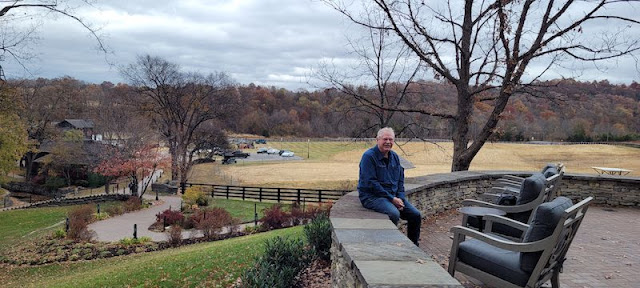 |
Maker’s Mark is a beautiful destination, even for non-bourbon drinkers. |
I also appreciated Mrs. Samuels's role in the business's development. While Bill Samuels, Jr., was reinventing the family’s six-generation-old bourbon recipe in 1953, his wife, Margie Samuels, was designing the most recognizable bourbon bottle anywhere. Today, visitors can hand-dip their own bottles in the hot red wax and create one-of-a-kind souvenirs.
 |
Maker’s Mark still uses the old wooden fermentation vats. |
Again, Roger left on a tour of the pastoral and immaculate distillery, once known as Star Hill Farm. I settled in the bar, wrote, and people-watched. Eventually, I couldn’t stand it any longer and wandered down the hill across Whiskey Creek to the gift shop, where I purchased various bourbon balls.
 |
Makers Mark celebrates co-founder Margie Samuels with a stained-glass enclosed vestibule housing her pewter collection and honoring her contributions to the family’s bourbon business. |
Roger reported that while he liked some of the more “high-end” bourbons he sampled, he was impressed with some of the more affordable bourbons from (to him) the lesser-known distilleries. He was impressed with the rye bourbons at Evan Williams and Old Forester and, of course, the “classically smooth” Maker’s Mark bourbon. His favorite is still the Angel’s Envy Carribean Cask finish.
We skipped drinking at Maker’s Mark—except for Roger’s tasting and tour—because we had a drive ahead of us to our campsite for the night, Mammoth Caves National Park, a place we almost missed. The next day was Halloween. What better way to spend it than wandering through the dark and creepy hollows of the earth?
 |
Maker’s Mark displayed images from old marketing campaigns. |
*******
Birds picked up in Louisville by Merlin Sound IDCarolina wren, Blue jay, Northern cardinal
*******
“To truly love we must learn to mix various ingredients—care, affection, recognition, respect, commitment, and trust, as well as honest and open communication.”
*******
© copyright 2022. Patricia E. Harding. All rights reserved.

















